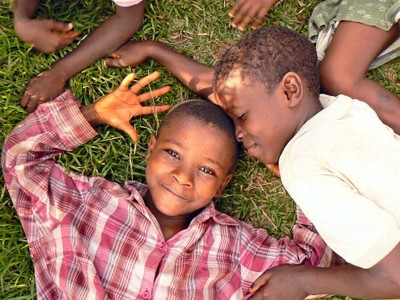Child Sponsorship Background from Freetown, Sierra Leone
 SOS Children's Village Freetown
SOS Children's Village Freetown
SOS
Children's Villages in Sierra Leone, a long-term partner of the
national government, was approached by the authorities already during
the war years in 1996, with the request to extend its activities and to
establish a third village. After thoroughly studying different sites the
provincial town Makeni, situated in the Bomabil District of the
Northern Province of Sierra Leone, about a hundred and sixty kilometres
from Freetown, was chosen as the new location. In 2007, the SOS
Children's Village Makeni including an SOS Nursery School and an SOS
Primary School started to operate. SOS Children's Village Freetown is
situated a little outside of the country's capital, on the main road
towards the Atlantic coast. Freetown with its more than 300,000
inhabitants is the cultural and industrial centre of the country. SOS
Children's Village Freetown consists of 13 family homes, the village
director's house, a guest house for co-workers, a house for retired SOS
mothers, two workshops, a clinic, an administration and service
area, an open round hut and a playground.
Other SOS Projects in Freetown
In 1978, an SOS Nursery School was opened at Freetown. It consists of five classrooms, a Montessori room, a crèche, a multi-purpose hall and a playground. The SOS Nursery is open to children from the local community as well. For youths from the SOS Children's Village, there is an SOS Youth Facility, which consists of five flats and a transit home (two flats for semi-independent youths). Young people from the SOS Children's Village usually move to the SOS Youth Facility around the age of 15.
With only one educator to take care of them, the youngsters are quite independent and have to take responsibility for their lives. For youngsters from the SOS Children's Villages, moving to an SOS Youth Home is usually the first step towards an independent life. SOS mothers, educators and village directors prepare the youngsters very carefully for this important step in their lives. Young people usually stay at the SOS Youth Facility until they have finished their education or training and found a job. This takes four years on average.
The SOS Primary and Secondary School includes a vocational school with many practical subjects. It consists of 18 classrooms (twelve primary school and six secondary school classes), dressmaker/tailor workshop, arts and crafts workshop, a physicochemical lab, a typing and computer lab, a library, a teaching kitchen and a play room. In addition, there is a canteen, an administration and service area, a multi-purpose hall and a playground.
The SOS Vocational Training Centre consists of three buildings with workshops, offices and a classroom for the different sections: computer-aided design, screen printing, lithography, offset printing and letterpress printing. The main aim is to provide youngsters both from the SOS Children's Village and from the local community with high-quality training. All in all, there are 15 places for trainees (girls and boys) aged between 16 and 22.
SOS Social Centre Freetown for children with special needs is the only facility of this kind in the region. It consists of a building for boys and one for girls, with a separate room for each child. Children are given special care and a special education with the aim to integrate them into society and to enable them to live independently within a short period of time. Therefore, some children only spend a certain amount of time at the SOS Social Centre before returning to their families. The second SOS Social Centre Freetown (family strengthening and community outreach programme) provides food to all students of the SOS Primary and Secondary School, and in some cases also to their parents.
SOS Social Centre Goderich is a family strengthening and community support project that provides help to approximately 200 children and youths and involves volunteers and elders from the community. Their main task is to work in close collaboration with the SOS co-workers in identifying beneficiaries within the community, checking their living conditions and the support needed and assisting in implementing the programme.
Background to Freetown
Freetown is the capital and largest city of Sierra Leone with a population estimated at over one million people. It is a major port city on the Atlantic Ocean. The city is the hub for the nation's administration, finance, education, communications, culture and economy. Founded in 1792 as a settlement for freed African Americans, liberated Africans, and West Indians slaves that arrived in the city from 1792 to about 1885 which later become home to Creoles (descendants of former American slaves).

 Return to Schools Wikipedia Home page…
Return to Schools Wikipedia Home page…
